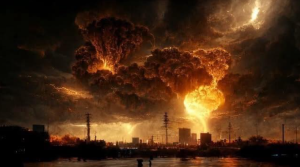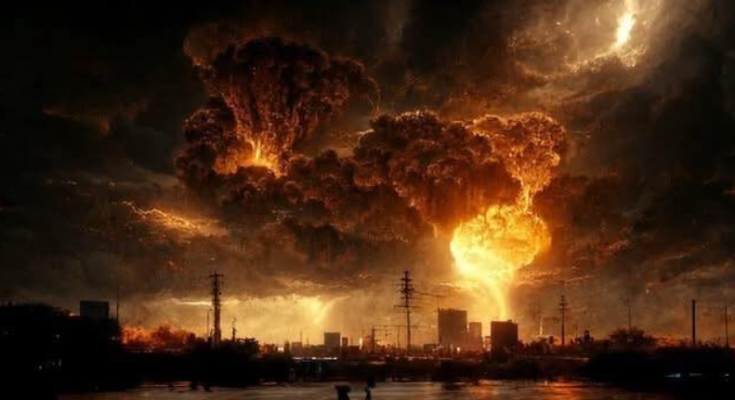
Søren Kierkegaard’s haunting metaphor of a fire in the theater—where a clown warns the audience of impending danger, only to be met with laughter and applause—is one of the most enduring parables in philosophy. It’s brief, vivid, and unsettling. But beneath its theatrical surface lies a profound lesson about denial, distraction, and the tragic consequences of ignoring truth when it’s dressed in unexpected clothing.
“A fire broke out backstage in a theater. The clown came out to warn the public; they thought it was a joke and applauded. He repeated it; the acclaim was even greater. I think the world will come to an end amid the general applause of people who believe it is a joke.” — Søren Kierkegaard
🎭 The Clown and the Crowd: A Tragic Miscommunication
At first glance, Kierkegaard’s image seems almost humorous—a clown, the very symbol of entertainment, trying to deliver a serious warning. But the tragedy lies in the mismatch between messenger and message. The audience, conditioned to laugh at the clown, cannot recognize the urgency of his words. They applaud, mistaking alarm for performance.
This is Kierkegaard’s central insight: truth is often dismissed not because of what is said, but because of who says it. The clown’s costume becomes a barrier to credibility. In today’s world, this dynamic plays out constantly—scientists ignored because they lack charisma, whistleblowers dismissed as disgruntled, activists mocked for their passion. The messenger is judged before the message is heard.
🔥 The Fire as Existential Crisis
The fire in the theater isn’t just literal—it’s symbolic. For Kierkegaard, it represents existential danger: the collapse of meaning, the erosion of truth, the spiritual emptiness of modern life. The audience’s reaction—laughter, applause, denial—is a metaphor for how society responds to uncomfortable truths. We distract ourselves. We entertain ourselves. We laugh in the face of crisis.
This metaphor resonates deeply in our age of climate warnings, political polarization, and digital overload. Experts raise alarms about environmental collapse, democratic erosion, mental health epidemics—and yet, much of society responds with memes, satire, or outright dismissal. The fire burns backstage, but the show goes on.
🧠 The Psychology of Denial
Kierkegaard’s parable also taps into the psychology of denial. When faced with overwhelming or frightening information, people often retreat into humor, disbelief, or distraction. It’s easier to laugh than to act. Easier to applaud than to investigate. The audience in the theater isn’t evil—they’re human. Their reaction is a defense mechanism.
This insight is especially relevant in times of crisis. During pandemics, wars, or social upheaval, misinformation and minimization flourish. People cling to normalcy, even as the backstage burns. Kierkegaard’s clown becomes a symbol of every ignored warning, every dismissed truth-teller.
📺 Entertainment vs. Awareness
The metaphor also critiques the role of entertainment in society. The theater is a place of illusion, of escape. When the clown breaks the fourth wall to deliver a real warning, the audience cannot shift gears. They’re too immersed in the spectacle. Kierkegaard warns that a culture addicted to entertainment may lose its ability to discern reality from performance.
In today’s media landscape, this warning feels prophetic. News is packaged as infotainment. Serious issues are reduced to soundbites. Influencers and entertainers often have more reach than experts. The clown’s dilemma is ours: how do you speak truth in a world that expects a show?
🪞 A Mirror for Modern Times
Kierkegaard’s metaphor is timeless, but its relevance has only grown. Consider the climate crisis. Scientists have warned for decades about rising temperatures, melting ice caps, and ecological collapse. Yet many still treat these warnings as exaggerations or political theater. The clown has spoken. The applause continues.
Or take the erosion of democratic norms. Journalists, historians, and civic leaders raise alarms about authoritarian drift, disinformation, and voter suppression. But in the noise of social media, these warnings are often drowned out by memes, outrage cycles, or celebrity gossip. The fire backstage spreads.
🫂 The Role of the Witness
Kierkegaard’s parable invites us to ask: who are we in the theater? Are we the clown, trying to speak truth in a world that laughs? Are we the audience, applauding while the fire grows? Or are we the rare witness—someone who hears the warning, sees the flames, and acts?
To be a witness is to resist denial. To listen deeply. To look beyond appearances. It means recognizing that truth may come in unexpected forms—from clowns, artists, children, or strangers. It means choosing awareness over amusement, action over applause.
🧭 Lessons for Today
Here are a few takeaways from Kierkegaard’s metaphor that feel especially urgent now:
- Take warnings seriously. Whether from scientists, journalists, or friends—listen before dismissing.
- Look beyond appearances. Don’t judge the message by the messenger’s costume.
- Balance joy and vigilance. Entertainment is vital, but not at the cost of ignoring real danger.
- Act, don’t just observe. Applause won’t stop the fire. Only action will.
🔮 The End Amid Applause
Kierkegaard’s final line is chilling: “I think the world will come to an end amid the general applause of people who believe it is a joke.” It’s a warning against complacency, against mistaking performance for reality. It’s a call to wake up.

